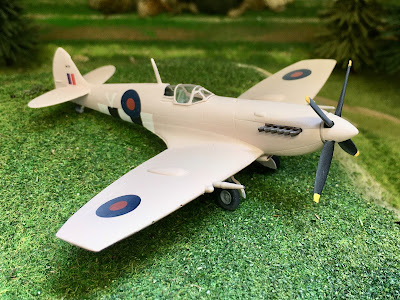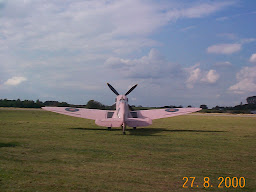For build 19 of my Lockdown Scale Modelling Project, I’ve selected a kit almost as vintage as the aircraft itself. This is Frog’s 1971 model of the de Havilland D.H.103 Hornet. Frog was a well-known British brand producing model kits between the 1930s to 1970s. Launched in 1932, they created the world’s first kits made from cellulose acetate. Polystyrene models were then introduced in 1955 and by the 1970s, Frog's catalogue included a large number of lesser-known aircraft types only to be manufactured by the company; such as this Hornet. The last Frog-branded kits were produced in 1976, whereupon many of the Frog moulds were sold to the Soviet Union to be marketed under the Novo name.
It was a real experience constructing this model. The instructions were considerably less detailed than today’s kit modellers would expect to find and in a musty condition that would not have been there when new! The decals also required quite some tempting to remove from their backing paper and liberal quantities of Decalfix fluid to soften and affix them to the finished model.
In finishing the build, I've tried a new painting technique, replacing my brushes with an airbrush and marking out the camouflage pattern with masking fluid. It was a challenging and lengthy process and only time will tell if I attempt it again!
 |
| My Frog 1:72 scale de Havilland D.H.103 Hornet |
The de Havilland D.H.103 Hornet, the forgotten successor of the very successful de Havilland Mosquito. While the Mosquito took multiple leading roles in World War Two and then went on to star in its own book and blockbuster film, 633 Squadron, the Hornet arrived too late to take up its intended role and was then quickly withdrawn from service on the arrival of the jet era.
The de Havilland Hornet represents in many ways the peak of piston engine fighter design. With its slim fuselage, clean lines and tightly cowled engines, great attention was paid from the outset on maximising performance.
 |
| The original de Havilland D.H.103 Hornet |
The Hornet prototype (RR915) flew for the first time on 28th July 1944. Powered by a pair of 2,070 hp Merlin engines driving opposite-handed propellers for increased stability and handling, it could reach an astonishing maximum speed of 485 mph at 22,000 ft, making it the RAF's fastest ever propeller aircraft.
Two main marks saw service with RAF Fighter Command: The F Mk 1 and the F Mk 3 with the latter (my model) having an increased fuel capacity and a large dorsal fin. For its standard armament it had four 20mm cannon in the nose and then an option of rockets, bombs or 200 gallon drop tanks carried under the wings.
It was conceived for operations in the Pacific Theatre against the Japanese, however, the conflict had ended before the aircraft reached operational status. It first saw combat in 1951, when Hornets were redeployed from Fighter Command to the 33, 45, 64 and 80 squadrons of the Far East Air Force (FEAF) to support ground security forces in operations against Communist guerrillas during the Malayan Emergency. The Hornets replaced the Bristol Beaufighters and Supermarine Spitfires that had been operating in Malaya since the outbreak of hostilities in 1948. With their long range and good endurance, they were able to spend hours loitering over a given target area, a key attribute when target identification was often very challenging and time consuming.
 |
| de Havilland Hornet refuelling at RAF Seletar, Singapore |
The Hornet proved to be very reliable; 45 Sqn Hornets, based in Singapore, achieved a total of 4,500 operational sorties over their five year tour of duty, more than any other squadron in the FEAF. However, with the evolution of longer-range jet-powered fighters such as the de Havilland Vampire, de Havilland Venom and Gloster Meteor, the Hornet became obsolete fairly quickly and on 21st May 1955, just as with the Spitfire a year earlier, the Hornet flew its last RAF operational sortie; another last flight of an RAF aircraft during this Malayan Emergency.
Sadly, the Hornet also had an Achilles heal. The glue which de Havilland used to bond its plywood skins proved susceptible to breaking down in the high heat and humidity of the tropics. The resulting de-lamination problems, coupled with termite issues have resulted in there being no complete examples of the Hornet remaining in existence today. However, remains of a de Havilland Sea Hornet, the aircraft carrier version as used by the Navy's Fleet Air Arm, was discovered in 2016 dumped on the edge of a Canadian airfield, and is now in the process of restoration in New Zealand. If it gets to fly, this will be one very rare aircraft.
While its predecessor, the Mosquito, appeared in that book made famous by the big screen, it is possible that the Hornet may have its own literary claim to fame by being flown by none other than Biggles!
 |
| Le Cygne Jaune |
In Le Cygne Jaune, a 1946 Biggles graphic novel by W. E. Johne, illustrated by Francis Bergèse, the Second World War is over and Air Commodore Raymond urgently persuades Biggles, Algy, Ginger and Bertie to join a special unit at Scotland Yard specialising in crimes committed with aircraft.
 |
| Spur prototype? |
To intercept airborne criminals, Biggles takes delivery of a Spur prototype which is still undergoing tests. The aircraft was a twin engined, advanced high performance, long-range fighter which was only prevented from making history by the termination of the war. Sound familiar?
While the Spur is, of course, a fictional aircraft, as Johns needed an advanced, late war design, it is not surprising that Francis Bergèse's Spur looks so much like that of a real Hornet!
 |
| Bergèse's remarkable attention to detail |
This scene at Croydon Airport shows Bergèse's remarkable attention to detail. With Croydon's apparently famous control tower, a Mosquito on the left and the Spur ... or may be a Hornet ... on the right!
---
The model:
Model: DH Hornet F.Mk.3 Long Range Fighter
Scale: 1:72
Item code: F239
Year of Release: 1971

























